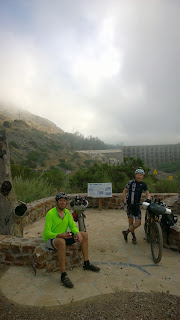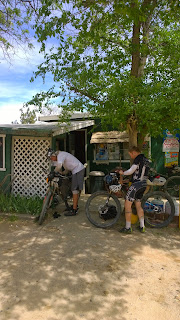I have been contacted several times in the last few months
about e-bikes and if they are compatible on our local trail systems. I was
asked by a couple of different companies if I would like to experience
firsthand what it was like riding a pedal assist e-bike. I had only ridden one
briefly around a parking lot sometime last year so I was curious to see for
myself.
Let’s take a step back. In October 2015 California passed
legislation that allowed e-bikes on bike pathways with certain restrictions
pertaining to the three types of e-bikes. It also allowed the different
municipalities and land managers to create their own rules and regulations
regarding the usage of e-bikes. Currently our rules and regulations do not
permit the usage of any motorized vehicle on the trail, or in any Open Space
Preserve in Southern California, that I am aware of.
As the bike industry grows the push to get e-bikes accepted
on all trails is growing as well. Part of this new push is to make the bike less
bulky and more like a traditional bike. Except it still has a motor and gears,
and still relies on the legislation passed in 2015 to dictate the standards.
Where my concern lies is the overall speed of the bike in a trail application.
I do see and understand the need for such a bike and even think they would and
probably have benefited a number of people. But……….
The e-bike I tested was the Trek Powerfly 8. It uses a pedal
assist Bosch electric system and tops out at 20mph. It is a full suspension
bike with a ton of travel and you even get a dropper post. All in a package
that probably weighs in close to 50 or 60lbs. Not a light bike at any standard
but it is carrying a motor and large battery. I spent a couple of weeks riding
it around the park and on other trails. Both in plain clothes and in uniform. I
put a little over 100 miles on it with one of the rides being 46 miles long. I
usually patrol the trails on bike so I compared it to my other patrol rides.
Was it fun? Sure it was a blast and I saved a ton of energy riding it. But
during my rides a number of concerns popped into my head that could potentially
negate any designation of e-bikes being allowed within a multi-use park setting.
Let’s say there was a “trail designation” within the parks
that allowed for the use of pedal assist e-bikes. What are the risks?
Concern number 1: Overall speed. There are four different
settings on the power supply each giving you more and more power to the motor.
Eco, Tour, Sport and Turbo. In my opinion there is no need for the upper range
settings. They are far too powerful and let you reach that 20mph cut off with
ease. Not a good combo when riding technical trails or uphill. There is no need
to be going that fast uphill. You could still get the benefit of the system
with it cutting off at say 13mph as opposed to 20mph. A high and a low setting
limited to 15 and 13mph would be more than sufficient. As is this would be the
number 1 factor in not letting them on the trails. I can do a 30 to 40mi patrol
on a regular bike and average about 11mph. On the pedal assist bike my average
over 46mi was 14.5 to 15mph. That’s a big difference!
Concern number 2: The sheer weight of it to me could be a
potential problem for both user and anyone that might have a run in with it on
the trails. While the SDRP does not have extremely technical trails you do have
to have some kind of bike handling skills and physicality to be able to
navigate them especially on a 50 to 60lb bike.
Concern number 3: Just how safe are the batteries that are
used in these bikes? Sure the industry has more than likely taken percussions
to make them as safe as possible. But there have already been a number of
documented instances where the batteries have caught fire. What if while riding
on the trail a crash happens that punctures the battery casing causing it to
catch fire? In an open space setting in the middle of a trail this could be
devastating to the natural environment as well as anybody living around the
park.
Concern number 4: As far as I know there is no insurance to
date that will even cover this type of vehicle. Thus making it a huge
liability.
I have seen and talked with the handful of users I have meet
using them. I get why they have chosen to ride one. 9 times out 10 it’s someone
that used to ride but now because of age or injury can no longer do the rides
they used to do. I totally get it and I may even be in that situation at some
point in my life. But without a responsible change in the bike industries to
even broach the subject of maybe working with land owners and managers to come
up with say a “Trail Designation” for these bikes. They will never be allowed
and at some point a hard stance will be taken against them.
Now for my personal opinion. While fun for a minute there is
no “pay-off” for me with these bikes. It in no way compares to riding the
trails that I do under my own power. I entered into a bike ride just recently
that is touted as “The Hell of the North County”. People train for months to be
able to try and do this ride and the dropout rate during the ride is high. While
on this ride I kept seeing a guy on an old touring bike with panniers passing
me on the uphill. I thought man that guy must tour all over the place thus
giving him legs for days. Out of sight out of mind. I forgot about him till the
last climb of the day. It was double peak a brute of a hill on any regular ride,
let alone towards the end of a this ride. I settled in and started to claw my
way up only to be passed by that same guy on his touring bike again. He was up
and down before I made it to the halfway point. Geez! Well kudos to him. I
finished, I’m beat but I’m happy. I see the bike a little later and walk up to it
only to find a motor strapped to its down tube. Whether it’s right or not I
felt insulted. I guess this may be a sign of the future but I believe without
the proper discourse it’s gonna get real ugly before we start to solve
anything.





























